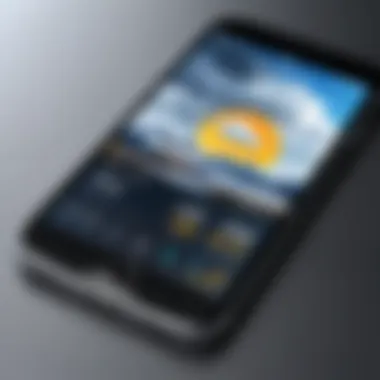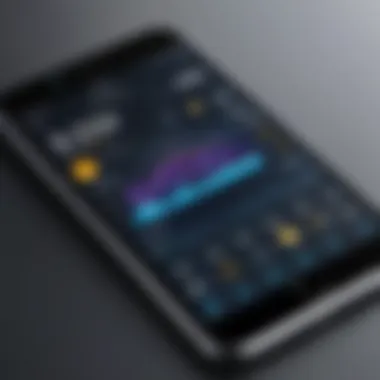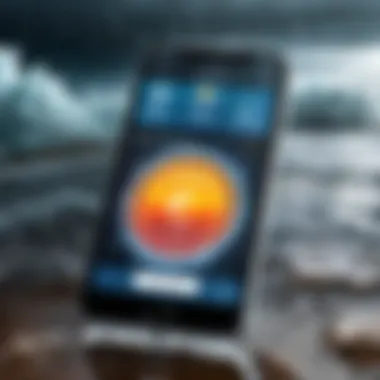The Best Weather Alert Apps for iPhone Users


Intro
In today's fast-paced world, where sudden weather shifts can derail plans faster than you can say "rain check," the need for reliable weather information is paramount. iPhone users, in particular, have a plethora of weather alert apps at their fingertips—but how do you sift through the noise and pinpoint the one that truly meets your needs? This article explores the feature-packed landscape of weather alert applications, carefully considering usability, reliability, and the unique functionalities each app brings to the table. With stormy skies and sun-kissed afternoons alike on the horizon, this guide prepares you to weather any storm, all while ensuring you make the right choice.
Understanding the Importance of Weather Alerts
The world's climate is becoming more unpredictable. From torrential downpours to heat advisories, staying ahead of severe conditions has become essential for not only safety but also planning daily activities. That’s why having an optimal weather alert app on your iPhone is no longer a luxury—it’s a necessity. Whether you’re a frequent traveler, an outdoor enthusiast, or simply want to avoid a drenching on your walk to the office, an effective weather alert app can provide timely notifications that empower you to act accordingly.
As we navigate this intricate web of available apps, we will highlight key points that influence decision-making, ranging from user experience to technological innovations. By the time you reach the end of this article, you’ll have the tools—literally and figuratively—to make an informed choice about your weather alert application, ensuring you’re never caught unawares by Mother Nature's whims.
Foreword to Weather Alert Apps
When it comes to staying safe in a world filled with unpredictable weather patterns, having a reliable weather alert app on your iPhone is a no-brainer. These apps have become essential tools, offering real-time updates on severe weather conditions that could impact our daily lives. Gone are the days when one would rely solely on newspaper forecasts or TV predictions, which often leave room for error. Modern technology has allowed for more precise and immediate weather monitoring, and that’s where these apps shine.
Significance of Weather Alerts
The importance of timely weather alerts cannot be overstated. Imagine planning a day out, unwittingly walking into the ominous shadow of a sudden storm. Or think about a family eagerly planning an outdoor gathering, only to be met with the onslaught of unexpected rain or worse. Weather alerts serve as a protective umbrella, arming users with necessary information to prepare for abrupt changes in weather.
- Safety First: Alerting users about thunderstorms, tornadoes, or hurricanes provides the chance to take cover or evacuate if necessary.
- Planning: Users can organize their day accordingly—whether it's rescheduling an outdoor wedding or choosing the best time for a jog without getting drenched.
- Travel Readiness: For those often on the road, driving through unpredictable weather can pose serious hazards. Having up-to-date information means you can adjust your route or timing.
"Preparedness is the first step to resilience."
Evolution of Weather Apps
Weather apps have come a long way since their inception. In the early days, apps merely mirrored TV broadcasts but with the added benefit of displaying multiple locations. However, rapid advancements in technology have transformed these tools into comprehensive weather stations in your pocket. Now, we see apps that use cutting-edge algorithms and satellite data to predict weather with startling accuracy.
- First Generation: Basic forecasts, often lacking real-time updates.
- Second Generation: Introduced features like radar maps and basic alerts, but still fell behind in accuracy.
- Current State: Incorporating AI and machine learning, present-day apps provide hyper-local forecasts, real-time warnings, and customizable notifications that allow for a tailored user experience.
- Future Trends: As tech continues to evolve, the integration of machine learning models may provide forecasts so precise, they could predict rain down to the minute.
So, as technology progresses, we are witnessing a shift not only in how we access weather information but also in how we prepare for it. Harnessing the power of these apps can make all the difference when the storm clouds gather.
Key Features of Weather Alert Apps
Selecting the right weather alert app for your iPhone involves more than just a pretty interface or a catchy name. In today’s world, where drastic weather changes can occur in the blink of an eye, the features of a weather alert app can make a world of difference. Users need to have access to timely and accurate information so they can plan their days accordingly. Each app offers varying functionalities that cater to different needs. Here we will delve into three critical aspects: Real-Time Notifications, Localized Forecasts, and Severe Weather Alerts. Each of these features is indispensable for anyone who desires to stay one step ahead of Mother Nature.
Real-Time Notifications
First off, let’s talk about real-time notifications. You might find it hard to argue against the necessity of instantaneous updates in our fast-paced lives. A reliable weather alert app sends notifications straight to your iPhone, so you can keep your finger on the pulse of what’s happening outdoors. Imagine this: you're on your way to an important meeting and you suddenly get an alert about a sudden storm brewing. That could save the day—or at least prevent you from getting drenched.
"In the end, it's not the gadgets we carry, but the information they provide that matters most."
Most apps will allow you to predefine which alerts you want to receive, whether that's heavy rain, snow, or temperature changes. This means that you won’t have to worry about getting pinged every five minutes—just the crucial moments that affect your day. The ideal app will also ensure that these notifications are immediate, so you can act quickly when advice comes through.
Localized Forecasts
Next, we arrive at localized forecasts. Remember the last time you relied on a generic weather forecast and ended up woefully unprepared? Probably standing in a downpour wearing nothing but a summer dress. Localized forecasts provide tailored updates specific to your geographic location. Whether you’re nestled in the heart of a bustling city or exploring the great outdoors, precise forecasts help you prepare accordingly.
With features ranging from hyper-local radar maps to minute-by-minute predictions, you can plan a picnic with confidence or know exactly when to bring in the patio furniture if a storm is rolling in. It’s the difference between, "Should I take an umbrella?" and "There's a 90% chance of rain in the next hour."
Severe Weather Alerts
Finally, let’s dive into severe weather alerts, which can be the difference between simply being inconvenienced and being truly alarmed. These alerts focus on hazardous situations like hurricanes, tornadoes, or floods. When such events strike, having an app that provides up-to-the-minute information can be life-saving.
Each app has its criteria for what counts as severe weather, so users should choose one that aligns with their geographical risks. When a tornado warning goes off, you want your app to alert you promptly so that you can take immediate action. It's about getting the information you need when it matters most.
Criteria for Choosing the Best App
When it comes to selecting the optimal weather alert app for iPhone users, having a set of clear criteria is crucial. Weather conditions can shift rapidly, and making an informed choice about the app you rely on not only enhances your understanding of impending weather changes but also helps you prepare effectively. Let’s delve deeper into the key considerations that streamline this selection process, focusing on user interface, data accuracy, customization options, and cost.
User Interface and Experience
A user-friendly interface can make or break your experience with an app. Imagine navigating through a maze to find crucial information—frustrating, right? A well-designed app should be intuitive, ensuring that every feature is just a tap away. Look for clean layouts, easy-to-read fonts, and logical organization of information. It's like choosing a book with an appealing cover and engaging content; you’re more likely to explore further.
- Simple Navigation: Check if the app allows for smooth transitions between different sections, such as forecasts, maps, and alerts.
- Visual Appeal: Good color schemes and interactive graphics can make data interpretation easier and more enjoyable. A swirling radar map is nice to look at but should also be clear.
- Accessibility Features: Consider whether the app accommodates users with visual impairments. Features like voice commands or text-to-speech can make a significant difference.
Accuracy of Data
Accuracy is perhaps the most vital aspect when it comes to weather alert apps. No one wants to be caught off guard by a sudden storm or unexpected temperature drop. Your chosen app should source data from reliable meteorological institutions and algorithms that have proven trustworthy.


- Data Sources: Look for apps that publicize their data providers. Well-known meteorological organizations offer more reliable forecasts.
- Update Frequency: Real-time updates are essential, especially during severe weather events. An app that takes too long to refresh its forecasts may leave you scrambling.
- Error Rate: Some apps are better than others at forecasting than, say, predicting rain when it only drizzles. Research user reviews—those tech-savvy individuals aren’t shy about sharing their experiences with faulty forecasts.
Customization Options
Every user has unique needs—what works for one person may not fit another. An app that allows customization can significantly enhance user satisfaction. You should be able to tailor alerts and features to suit your geographic location and personal preferences.
- Location-Based Alerts: Some apps let you set alerts for multiple locations, perfect for travelers or those with family living elsewhere.
- Personalized Notifications: Choosing which weather events you want to be alerted about can lessen the noise of constant notifications about less pertinent weather changes.
- Theme Adjustments: Operating a weather app should be as pleasurable as possible; customizable themes can add a personal touch.
Cost and Subscription Models
Finally, let’s talk dollars and cents. The market is brimming with both free and paid options. If you find yourself gravitating toward a subscription service, make sure it offers value that justifies the price.
- Free vs. Paid Features: Some apps offer robust free versions but may lock essential features behind a paywall. Knowing which features merit a price tag can save you some dough.
- Trial Periods: Take advantage of any free trials offered. It’s a great way to assess if the app meets your needs before committing to a subscription.
- User Reviews on Pricing: Often, readers can shed light on whether the paid features deliver as promised. Don’t forget to involve the community—check discussions on platforms like reddit.com for firsthand experiences.
In summary, selecting the right weather alert app isn't just about choosing the most popular one; it entails one’s priorities regarding usability, data reliability, customization, and budget.
By weighing these criteria, iPhone users can find an app that not only meets their expectations but also enhances their readiness for whatever Mother Nature throws their way.
In-Depth Reviews of Prominent Weather Alert Apps
When it comes to staying ahead of unpredictable weather, specific applications can provide users with vital information and alerts. Diving deep into each app's effectiveness can help pinpoint those that truly deliver in quality and utility. Understanding the strengths and weaknesses of different weather alert apps is crucial for iPhone users who want to make informed decisions about their weather-monitoring needs.
The Weather Channel App
Overview and Key Features
The Weather Channel App is a standout in the realm of weather applications, known for its comprehensive coverage and reliability. One of its primary attributes is the interactive radar, which offers users a visual depiction of precipitation and storm paths. This feature makes it easy for iPhone users to anticipate changing conditions. Additionally, the app includes hourly forecasts, which are updated every few minutes, allowing for immediate awareness of adverse weather. Its severe weather alerts can be particularly lifesaving, notifying users of approaching storms or severe conditions that could impact daily plans.
What differentiates this app from others is its emphasis on localization, offering hyper-local forecasts. However, while the breadth of information is extensive, some users might find the amount of data a bit overwhelming, especially those who prefer a straightforward weather report.
User Experience and Interface
Navigating the Weather Channel App generally feels intuitive, thanks to its well-designed user interface. The incorporation of simple icons and a clean layout assists users in finding information quickly. Customization options also enhance the user experience, allowing individuals to adjust the dashboard to display their preferred metrics.
That said, some users have pointed out that the app can be a bit slow to load, particularly during high-traffic weather events like hurricanes or snowstorms. This lag time can be frustrating for users eagerly seeking updates.
Pros and Cons
Pros:
- Comprehensive and accurate weather data
- Real-time severe weather alerts
- User-friendly interface with customization options
Cons:
- May feel overwhelming to some users
- Occasional slow load times during peak events
AccuWeather
Overview and Key Features
AccuWeather prides itself on accuracy, making it a popular choice among users seeking reliable forecasts. One standout feature is the MinuteCast, providing minute-by-minute precipitation forecasts for the next two hours, helping users plan their day accordingly. Furthermore, the app's long-range forecasts extend up to 90 days, surpassing some competitors.
The app also offers exclusive local forecasts, proving its value to users who need precise updates for their exact location. One downside, however, is that ads can sometimes disrupt the user experience, particularly in the free version of the app.
User Experience and Interface
The interface of AccuWeather is clean and accessible, which enables users to filter through the information quickly. The forecast is neatly organized, with a timeline for upcoming conditions. A notable element here is the map feature, which allows users to visualize weather patterns.
However, while many may appreciate the well-structured design, others might miss the more whimsical designs that some other weather apps provide, feeling that it lacks a bit of personality in its visual representation.
Pros and Cons
Pros:
- Highly accurate forecasts
- Minute-by-minute precipitation tracking
- Comprehensive long-range weather prediction
Cons:


- Advertisements in the free version can be disruptive
- Lack of visual flair in interface design
Weather Underground
Overview and Key Features
Weather Underground is distinct due to its focus on community-generated data. Users have access to personal weather stations, which contribute local observations that can make the forecasts even more reliable. This application also provides a detailed pollen count feature which is beneficial for allergy sufferers.
A unique advantage is this app's severe weather alerts and forecasts that are customizable by regions, ensuring users are always informed about local emergencies, creating a sense of community in weather monitoring. However, while this level of detail is impressive, it may not be ideal for users who prefer straightforward data without the clutter.
User Experience and Interface
The user interface of Weather Underground is straightforward but presents a wealth of data, which can be intimidating for new users. The graphics and visualizations are engaging, providing real-time data at a glance. However, a hiccup noted by users is that navigating through all options can feel convoluted at times.
Pros and Cons
Pros:
- Community-generated data increases local forecast accuracy
- Customizable severe weather alerts
- Rich visual data representations
Cons:
- May overwhelm users with too much information
- Can be tough to navigate through the various options
Dark Sky
Overview and Key Features
Dark Sky gained popularity for its hyper-local focus and precise weather predictions, utilizing advanced technology to provide detailed forecasts. Notably, it features down-to-the-minute rain predictions, allowing users to know if they have enough time to complete their errands before rain hits. Such precision is undoubtedly a game-changer for someone planning outdoor activities.
However, users should be aware that after its acquisition by Apple, the app is no longer standalone, instead feeding into Apple's Weather app. This might limit its original accessibility and specific features that some loyal users valued.
User Experience and Interface
The aesthetic design of Dark Sky is somewhat minimalistic but highly functional. Its emphasis on visuals such as the animation of rain and cloud patterns is appreciated by many. Yet, since the acquisition, some users have noticed a decrease in the app's responsiveness and have expressed frustration due to less frequent updates.
Pros and Cons
Pros:
- Highly precise, hyper-local weather data
- Great visual design and animations
Cons:
- Limited features in the new Apple Weather integration
- Performance issues post-acquisition
Apple Weather
Overview and Key Features
The Apple Weather app is inherently built into iPhones and provides standard weather information including forecasts, alerts, and radar. What sets it apart is its seamless integration with the Apple ecosystem, allowing easy access across devices. Users appreciate its uncomplicated interface that highlights essential information without unnecessary fluff.
Nevertheless, it may not provide the depth of features found in stand-alone weather applications drawn for more enthusiastic weather trackers.
User Experience and Interface
The user experience here is straightforward, boasting a clean and modern interface that iPhone users generally find easy to navigate. Integration allows for automatic updates and alerts across all Apple devices, syncing perfectly.
However, some users might find it lacks versatility compared to other apps that offer more advanced forecasting.
Pros and Cons
Pros:
- Intuitive and seamless integration with Apple devices
- Clean, straightforward user interface
Cons:


- Limited functionality compared to specialized apps
- May not suffice for users who desire detailed weather analytics
By exploring these prominent weather alert apps, it's easier for users to weigh their options and identify which features align best with their personal needs, ultimately enhancing their ability to remain prepared as the weather unfolds.
Comparative Analysis of Top Apps
The world of weather alert apps can feel a bit like wading through a thicket, especially with so many options available for iPhone users. A detailed comparative analysis is not just useful—it's essential. By examining top contenders side-by-side, users can identify which applications truly bring the most to the table based on features, user experiences, and practical reliability. A thorough approach enables users to sift through the noise and focus on what matters most, which is really a blend of functionality, user-friendliness, and accuracy.
In today's society, where immediate weather updates can mean the difference between feeling secure or facing unforeseen challenges, selecting the right app is crucial.
Feature Comparison
When it comes to comparing features, it’s about weighing what each app can offer against your personal needs. Different users prioritize different aspects, whether it be depth of data or ease of use. Key features often to consider include:
- Real-time notifications: How quickly does the app alert you to severe weather? Some apps may send instant alerts, while others might lag behind.
- Localized forecasts: It's one thing to know a weather system is coming, but how specific can the app get? Localized data can be crucial in areas prone to microclimates.
- Interactive maps: Maps that show real-time weather patterns can be a game changer. Some apps provide radar views, while others offer stunning satellite imagery.
- Widgets: For those who prefer quick access on their home screens, the presence of informative widgets can enhance daily usability.
Understanding how each of these features stacks up against one another is vital. An app that might excel in one category could falter in another, so it’s important to consider what aspects will most enhance your experience.
User Ratings and Reviews
User ratings and reviews act as a barometer for real-world performance. Just as a weather app is only as good as the data it provides, its value can often be measured by the experience of its users. Here are a few things to keep in mind:
- Overall ratings: Look past the stars and focus on the number of reviews. An app with an average rating of 4.5 based on 100 reviews may be less reliable than one with a 4.0 rating based on several thousand reviews.
- Detailed reviews: What are users saying? Pay attention to comments on specific features. It’s not uncommon to find consistent patterns in feedback regarding ease of use, accuracy, or customer support responsiveness.
- Update frequency: Is the app consistently receiving updates? Regular updates can be a strong indicator that the developers care about improving reliability and accuracy.
The Future of Weather Alert Apps
The landscape of weather alert apps is primed for transformation as technology leaps forward at breakneck speed. Understanding the future of these applications is crucial, especially for iPhone users who want to be informed and prepared. With the integration of sophisticated technologies like artificial intelligence and machine learning, these apps promise more than just basic weather updates. They are becoming smarter, more intuitive, and significantly more personalized.
Predicting weather patterns can reduce risks in various scenarios, from planning outdoor events to safeguarding lives during severe storm warnings. As such, innovations in this sector are not just beneficial; they’re becoming essential.
Integrating AI and Machine Learning
Artificial intelligence and machine learning are set to revolutionize how weather alert apps function. These technologies enable applications to analyze vast amounts of meteorological data in real-time, leading to more accurate forecasts and timely alerts.
Some significant benefits include:
- Enhanced Accuracy: AI algorithms can process historical weather data along with current conditions to forecast more accurately. This reduces the margin of error that often accompanies traditional methods.
- Personalized Alerts: Future apps will likely learn user habits and preferences. For instance, if a user often checks weather alerts before heading to work, the app can prioritize that information, streamlining the user's experience.
- Predictive Analytics: With advanced analytics, apps could anticipate extreme weather conditions before they hit, allowing users to receive early warnings tailored to their geographic location.
Implementing machine learning can also mean that the app evolves continuously, improving its response based on user feedback and usage patterns. It’s not just about having the data; it’s about how effectively it gets presented and utilized by users.
Trends in User Preferences
Shifts in user preferences play a pivotal role in shaping the future of weather alert apps. As technology evolves, so does user expectation. Today’s users seek not only reliability in weather information but also engagement in how that information is presented. Some notable trends are:
- User Interface Customization: People want to tailor their experience within the app. Customizable dashboards and alert settings ensure that users can set the app to their needs.
- Focus on Localized Information: With a growing appreciation for locality, users prefer apps that provide hyper-localized weather information. This means fewer generalized forecasts and more specific alerts based on urban neighborhoods or rural regions.
- Community Engagement Features: Many users enjoy sharing weather experiences. Apps incorporating social features, such as community reports and sharing functionalities, can enhance user engagement and thus may become more popular.
"Weather apps are not just tools anymore; they're becoming an integral part of our daily decision-making processes."
As tech-savvy individuals continue to seek deeper engagement from their apps, developers are faced with the challenge of creating intuitive, feature-rich platforms that also meet real-world needs. The race is on for weather alert applications that not only provide timely alerts but also engage users in ways that feel personal and impactful.
Adapting to these trends while incorporating cutting-edge technology will be pivotal for developers aiming to capture the attention of discerning users. The future indeed looks promising for those willing to innovate and listen closely to their audience.
Culmination
Weather alert apps are more than just convenient tools; they play a crucial role in personal safety and preparedness in today's unpredictable climate landscape. In this article, we dissected various applications aimed at delivering timely weather information to iPhone users. The importance of this topic cannot be overstated, particularly as severe weather events become more frequent and intense, making reliable forecasting essential.
Summary of Findings
Through our comprehensive evaluation, we find that not all weather alert apps are created equal. Key elements that rise to the forefront include
- Real-time notifications that quickly inform users of changing weather conditions, enabling them to act swiftly to protect themselves and their property.
- Localized forecasts that help users understand weather patterns specific to their location, fostering a sense of awareness tailored to their needs.
- The necessity for accurate data, which varies between apps but is critical to ensuring that individuals can trust the alerts they receive.
- User interface appears to be a strong determining factor for app usability; simplicity and clarity can significantly enhance user experience.
From the in-depth reviews, it's clear that while each application has its unique strengths, factors such as user ratings, data accuracy, and real-time notifications are paramount in establishing a solid recommendation.
"In weather forecasting, reliability and promptness are like water—essential for survival."
Final Recommendations
Taking everything into account, here are some final tips for choosing the best weather alert app:
- Assess Your Needs: Consider what features matter most to you, whether it’s severe weather alerts for travel, daily forecasts, or family safety notifications.
- Try Them Out: Many apps offer free trials or basic versions. Experimenting with a couple can provide insight into what interface and features you prefer.
- Check Reviews: User ratings and community feedback often reveal insights that you might miss from the app descriptions alone.
- Customize Notifications: Look for apps that allow you to tailor alerts according to your preferences, ensuring you’re not overwhelmed with unnecessary notifications.
Ultimately, the best weather alert app will vary for each individual based on personal preferences and specific situational needs. As weather patterns evolve, staying informed through the right application will empower iPhone users to face the elements head-on.



